Effect of the cross-flow wake on the hydrodynamic performance of the HSP propeller by the CFD solver
IF 4.4
4区 工程技术
Q1 Engineering
Journal of Marine Engineering and Technology
Pub Date : 2021-03-01
DOI:10.1080/20464177.2021.1893136
引用次数: 2
Abstract
This paper numerically presented the effect of the cross-flow wake on the hydrodynamic performance of the ship propeller. The propeller is a typical high skewed propeller (HSP) of the training ship ‘Seiun-Maru’, whose experimental data have been frequently used by many researchers. The viscous flow is solved by an incompressible Reynolds Averaged Navier–Stokes (RANS) method using Ansys-CFX solver. The shear stress transport (SST) k–ω turbulence model is employed for the simulation of the propeller in a fully turbulent flow. The thrust and torque coefficients at 10 presented advance coefficients (between 0.1 and 1) showed good agreement comparing with experimental data. The numerical results are increased in the wake flows. The unsteady oscillating load of thrust and torque is presented and discussed for one blade and whole blades during one cycle at different cross-flow wakes and at advance coefficient (J = 0.85). Based on the numerical results, when the cross-flow wake is increased by 20% and 50%, the thrust at J = 0.85 are increased about 2.03% and 4.71% respectively and the torque at J = 0.85 is increased about 1.04% and 2.69%, respectively. Moreover, pressure distribution and streamlines are also presented and discussed.用CFD求解器求解横流尾迹对HSP螺旋桨水动力性能的影响
本文数值模拟了横流尾流对螺旋桨水动力性能的影响。该螺旋桨是训练船“Seiun Maru”的典型高斜螺旋桨,其实验数据被许多研究人员频繁使用。粘性流通过不可压缩雷诺平均纳维-斯托克斯(RANS)方法使用Ansys CFX求解器求解。剪切应力传输(SST)k–ω湍流模型用于模拟螺旋桨在完全湍流中的流动。与实验数据相比,10时的推力和扭矩系数显示出良好的一致性。数值结果在尾流中有所增加。给出并讨论了在不同横流尾流和提前系数(J = 0.85)。根据数值结果,当横流尾流增加20%和50%时,J处的推力 = 0.85分别增加了约2.03%和4.71% = 0.85分别提高了1.04%和2.69%。此外,还介绍和讨论了压力分布和流线。
本文章由计算机程序翻译,如有差异,请以英文原文为准。
求助全文
约1分钟内获得全文
求助全文
来源期刊

Journal of Marine Engineering and Technology
工程技术-工程:海洋
CiteScore
5.20
自引率
0.00%
发文量
0
审稿时长
>12 weeks
期刊介绍:
The Journal of Marine Engineering and Technology will publish papers concerned with scientific and theoretical research applied to all aspects of marine engineering and technology in addition to issues associated with the application of technology in the marine environment. The areas of interest will include:
• Fuel technology and Combustion
• Power and Propulsion Systems
• Noise and vibration
• Offshore and Underwater Technology
• Computing, IT and communication
• Pumping and Pipeline Engineering
• Safety and Environmental Assessment
• Electrical and Electronic Systems and Machines
• Vessel Manoeuvring and Stabilisation
• Tribology and Power Transmission
• Dynamic modelling, System Simulation and Control
• Heat Transfer, Energy Conversion and Use
• Renewable Energy and Sustainability
• Materials and Corrosion
• Heat Engine Development
• Green Shipping
• Hydrography
• Subsea Operations
• Cargo Handling and Containment
• Pollution Reduction
• Navigation
• Vessel Management
• Decommissioning
• Salvage Procedures
• Legislation
• Ship and floating structure design
• Robotics Salvage Procedures
• Structural Integrity Cargo Handling and Containment
• Marine resource and acquisition
• Risk Analysis Robotics
• Maintenance and Inspection Planning Vessel Management
• Marine security
• Risk Analysis
• Legislation
• Underwater Vehicles
• Plant and Equipment
• Structural Integrity
• Installation and Repair
• Plant and Equipment
• Maintenance and Inspection Planning.
 求助内容:
求助内容: 应助结果提醒方式:
应助结果提醒方式:


